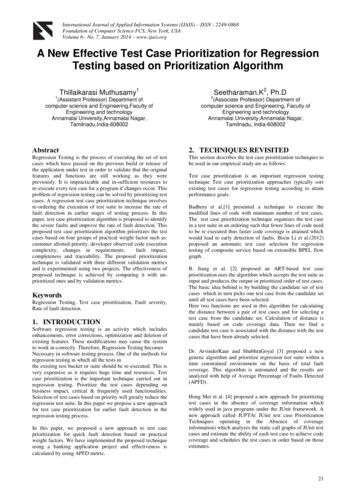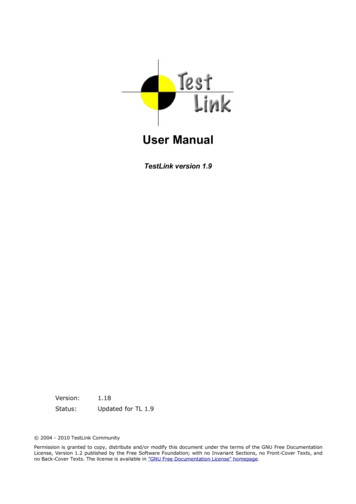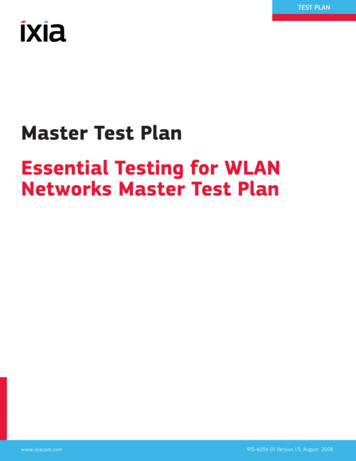
Transcription
International Journal of Applied Information Systems (IJAIS) – ISSN : 2249-0868Foundation of Computer Science FCS, New York, USAVolume 6– No. 7, January 2014 – www.ijais.orgA New Effective Test Case Prioritization for RegressionTesting based on Prioritization Algorithm1Thillaikarasi Muthusamy1(Assistant Professor) Department ofcomputer science and Engineering,Faculty ofEngineering and technologyAnnamalai University,Annamalai Nagar,Tamilnadu,India-6080022Seetharaman.K2, Ph.D(Associate Professor) Department ofcomputer science and Engineering, Faculty ofEngineering and technologyAnnamalai University,Annamalai Nagar,Tamilnadu, India-608002Abstract2. TECHNIQUES REVISITEDRegression Testing is the process of executing the set of testcases which have passed on the previous build or release ofthe application under test in order to validate that the originalfeatures and functions are still working as they werepreviously. It is impracticable and in-sufficient resources tore-execute every test case for a program if changes occur. Thisproblem of regression testing can be solved by prioritizing testcases. A regression test case prioritization technique involvesre-ordering the execution of test suite to increase the rate offault detection in earlier stages of testing process. In thispaper, test case prioritization algorithm is proposed to identifythe severe faults and improve the rate of fault detection. Thisproposed test case prioritization algorithm prioritizes the testcases based on four groups of practical weight factor such as:customer allotted priority, developer observed code executioncomplexity, changes in requirements,fault impact,completeness and traceability. The proposed prioritizationtechnique is validated with three different validation metricsand is experimented using two projects. The effectiveness ofproposed technique is achieved by comparing it with unprioritized ones and by validation metrics.This section describes the test case prioritization techniques tobe used in our empirical study are as follows:KeywordsRegression Testing, Test case prioritization, Fault severity,Rate of fault detection.1. INTRODUCTIONSoftware regression testing is an activity which includesenhancements, error corrections, optimization and deletion ofexisting features. These modifications may cause the systemto work in-correctly. Therefore, Regression Testing becomesNecessary in software testing process. One of the methods forregression testing in which all the tests inthe existing test bucket or suite should be re-executed. This isvery expensive as it requires huge time and resources. Testcase prioritization is the important technique carried out inregression testing. Prioritize the test cases depending onbusiness impact, critical & frequently used functionalities.Selection of test cases based on priority will greatly reduce theregression test suite. In this paper we propose a new approachfor test case prioritization for earlier fault detection in theregression testing process.In this paper, we proposed a new approach to test caseprioritization for quick fault detection based on practicalweight factors. We have implemented the proposed techniqueusing a banking application project and effectiveness iscalculated by using APFD metric.Test case prioritization is an important regression testingtechnique Test case prioritization approaches typically sortexisting test cases for regression testing according to attainperformance goals.Badhera et al.[1] presented a technique to execute themodified lines of code with minimum number of test cases.The test case prioritization technique organizes the test casein a test suite in an ordering such that fewer lines of code needto be re executed thus faster code coverage is attained whichwould lead to early detection of faults. Bixin Li et al.(2012)proposed an automatic test case selection for regressiontesting of composite service based on extensible BPEL flowgraph.B. Jiang et al. [2] proposed an ART-based test caseprioritization uses the algorithm which accepts the test suite asinput and produces the output in prioritized order of test cases.The basic idea behind is by building the candidate set of testcases which in turn picks one test case from the candidate setuntil all test cases have been selected.Here two functions are used in this algorithm for calculatingthe distance between a pair of test cases and for selecting atest case from the candidate set. Calculation of distance ismainly based on code coverage data. Then we find acandidate test case is associated with the distance with the testcases that have been already selected.Dr. ArvinderKaur and ShubhraGoyal [3] proposed a newgenetic algorithm and prioritize regression test suite within atime constrained environment on the basis of total faultcoverage. This algorithm is automated and the results areanalyzed with help of Average Percentage of Faults Detected(APFD).Hong Mei et al. [4] proposed a new approach for prioritizingtest cases in the absence of coverage information whichwidely used in java programs under the JUnit framework. Anew approach called JUPTA( JUnit test case PrioritizationTechniques operating in the Absence of coverageinformation) which analyzes the static call graphs of JUnit testcases and estimate the ability of each test case to achieve codecoverage and schedules the test cases in order based on thoseestimates.21
International Journal of Applied Information Systems (IJAIS) – ISSN : 2249-0868Foundation of Computer Science FCS, New York, USAVolume 6– No. 7, January 2014 – www.ijais.orgH.Do et al. [5] presented the effects of time constraints on testcase prioritization and find that constraints which alters thetechnique performance. They conducted three set ofexperiments which exhibits the time constraints. Theexperiment results show that the time constraint factor showsthe significant role in determining the cost effectiveness andcost benefit trade-offs among the techniques. Next experimentreplicates the first experiment, controlling for several threatsto validity including numbers of faults present, and thirdexperiment manipulates the number of faults present inprograms to examine the effects of faultiness levels onprioritization and shows that faultiness level affects therelative cost-effectiveness of prioritization techniques.Park et al. [6] introduced a cost cognizant model for the testcase prioritization and fault severities revealed in the lackprevious test execution does not significantly change form onerelease to another. Mohamed A Shameem et al. (2013)presented a metric for assessing the rate of fault dependencydetection. This algorithm identifies the faults in earlier stagesand the effectiveness of the prioritized test cases are comparedwith the non prioritized ones by Average Percentage Of FaultDetected (APFD).M. Yoon et al. [7] proposed a method to prioritize new testcases by calculating risk exposure value for requirements andanalyzing risk items based on the calculation to evaluaterelevant test cases and thereby determining the test casepriority through the evaluated values. Moreover, wedemonstrate effectiveness of our technique through empiricalstudies in terms of both Average Percentage Of FaultDetected (APFD) and fault severity.3. PROPOSED WORKThis section, we briefly discuss about the prioritizationfactors.3.1 Prioritization Weight FactorsComputation of proposed practical prioritization factorssuch as (1) customer allotted priority , (2) developer observedcode execution complexity, (3) changes in requirements, (4)fault impact (5) completeness and (6) traceability , isessential for prioritizing the test cases because they are used inthe prioritization algorithm. Weights are assigned to each testcase in the software according to these factors. Then, testcases are prioritized based on the weights assigned.3.1.1 Customer-Allotted Priority (CP)It is a measure of the implication of a requisite to thecustomer. The values of each need are assigned by thecustomers. The values vary from 1 to 20, where 20are used toidentify the highest customer priority. So, improvingcustomer’s fulfillment imposes the initial testing of thehighest priority needs of the customers. Greater effort shouldbe consumed in identifying faults and their impacts that takeplace on the execution path of program as these faults resultsin repeated failures. It has been proved that customer-Allottedvalue and satisfaction can be improved by fixing on customerneeds for development.3.1.2 Developer-observed Code ImplementationComplexity(IC)R. Abreu et al. [8] proposed a Spectrum-based multiple faultlocalization method to find out the fault location veryclearly.R. Bryce et al. (2011) proposed a model which definesprioritization criteria for GUI and web applications in eventdriven software. The ultimate goal is to evolve the model andused to develop a unified theory of how all EDS should betested.It is an individual measure of the complexity expected bythe development team in implementing the necessity. Firstevery necessity is evaluated. The developer assigns a valuefrom 1 to20 on the basis of its implementation complexity anda higher complexity is implied by a larger value. Largenumber of faults that could be occurs in a requirement that hashigh implementation complexity.R. Krishnamoorthi and S. A. Mary [9] presented a modelprioritizes the system test cases based on six factors: customerpriority, changes in requirement, implementation complexity,usability, application flow and fault impact. This prioritizationtechnique is experimented in three phases with studentprojects and two sets of industrial projects and the resultsimproved the rate of severe fault detection3.1.3 Changes in Requirements (RC)S. Raju and G.V. Uma [10] introduced a cluster-based testcase prioritization technique. By clustering test cases, basedon their dynamic runtime behavior researchers can reduce therequired number of pair-wise comparisons significantly.Researchers present a value-driven approach to system-leveltest case prioritization called the prioritization of requirementsfor test. In this approach, prioritization of test cases is basedon four factors rate of fault detection, requirements volatility,and fault impact and implementation complexity.The rest of this paper is organized as follows. In section threediscusses about the proposed work. Section four discussesabout the experimental results and analysis. Section fivediscusses about the discussions. And finally, section sixconsists of conclusion. References are given in last section.It is a degree assigned by the developer in the range of 1 to20 for indicating the number of times a requirement ischanged in the development cycle with respect to its origindate. The volatility values for all the needs are expressed on a20-point scale is the need is altered more than 20 times. Thenumber of changes for any requirement i divided to thehighest number of changes for any requirement among all theproject requirements yields the change in requirement Ri ofthat requirement i. If the ith requirement is changed M timesand N is the maximum number of requirements then therequirement change of i, Ri can be calculated in Eqn(1) asRi (M /N) 10(1)The errors introduced in the requirement level areapproximated to 50% of all faults detected in the project. Thechange in requirements is the major factor attributable to thefailure of the project.22
International Journal of Applied Information Systems (IJAIS) – ISSN : 2249-0868Foundation of Computer Science FCS, New York, USAVolume 6– No. 7, January 2014 – www.ijais.org3.1.4 Fault Impact of Requirements (FI)It allows the development team to distinguish the requirementthat had customer reported failures. Developers can recognizerequirements that are expected to be error free by using theprior data collected from older versions as a system evolves toseveral versions. The number of in-house failures and fieldfailures determine the fault impact of requirements. It ismeasured for those that have been in a released product. It isproved field failures are caused more likely to be fault pronemodules than modules that are not fault prone.3.1.5 Completeness (CT)This part indicates what is needed as per the requirement for afunction to be executed, the rate of success, the limitations tobe followed for the function is to be executed and anylimitation which manipulate the expected solution forexample the boundary constraints. The consumer assignsvalue from 1 to 20.When the condition is selected for reuseafter scrutinizing the completeness of each requirement intoconsideration, customer satisfaction like stronghold of thesoftware response to the user request can be enhanced.The computation of WPV for a requirement is used incomputing the Weighted Priority (WP) for its associated testcases. Let there be n total requirements for a product and testcase j maps to i requirements. Weighted Priority (WP) iscalculated in Eqn(3) asWPj x/y)(3)By calculating these values we can prioritize the test casesbased on WPV and WP for each and every test case in the testsuite. Fig. 1 shows, which explains the overview for theproposed prioritization approach which comprises ofprioritization factor values for each test case normalized to 20values and we can prioritize those test cases based onweighted priority value then produces the prioritized testsuite.3.1.6 Traceability (TR)Relation between requirement and assessment can becalibrated by means of Traceability. Defining whether arequirement is properly tested is cumbersome for evaluators.If the test cases are not concerned to individual requirement,the common problem reported is scarcity of traceability,hence poor traceability leads to failure and going beyond thedesired limit of the project. It is executed by undergoingprécised way rather than a conventional process. Most of theminor cases for software failures are identified due to lack oftraceability. Requirement traceability may be defined asability to monitor life of requirement in either ways i.e. fromthe inception through construction and specification and forits subsequent execution and usage through steps ofcontinuous advancement and recurrence in any of the stages.The evaluator allots value in the range from 1 to 20, afterassessing individual requirement for the concernedtraceability and the standard of software can be improved byopting the traceability of the requirement into consideration ischosen for subsequent usage.3.2 Proposed Prioritization Algorithm:Values for all the 6 factors are assigned for each test caseduring test design analysis phase and evolve continuallyduring software development process. We can computeweighted prioritization value (WPV) for each test case ishown in Eqn(2)WPV i*PFweighti)(2)Where,WPV is weight prioritization for each test casecalculated from 10 factors.PF valuei is a value assigned to each test case.PF weightiis a weight assigned for each factor.Fig. 1 Overview of the implementation of proposed techniqueNow we introduce the proposed technique in analgorithmic form here under: This algorithm calculates WPV(weighted priority value) and WP (Weighted Priority) forevery test cases which takes into the account of un-prioritizedtest input. Then any sorting algorithm like quick sort or heapsort can be implemented to sort the WP values in descendingorder.3.2.1. AlgorithmInput: Test Case Set (denoted as TS)Output: Prioritized Test Suite (denoted as PS)General Process:BeginFor each test case t in TSCalculate WPV for tEnd forWhile TS is not empty doCalculate WP in TSEnd WhileSort t in descending order based WeightageAdd t to PSReturn PSEnd23
International Journal of Applied Information Systems (IJAIS) – ISSN : 2249-0868Foundation of Computer Science FCS, New York, USAVolume 6– No. 7, January 2014 – www.ijais.org(a)(c)(b)( d)Fig. 2 The samples of (a).Requirement for entering account number (The field must be in integer), (b). the sample screen forwithdrawal operation, (c). The fault occurs during the bank account creation for the same account number, (d). Final screen forproposed prioritization technique24
International Journal of Applied Information Systems (IJAIS) – ISSN : 2249-0868Foundation of Computer Science FCS, New York, USAVolume 6– No. 7, January 2014 – www.ijais.orgANDThe test case prioritization system is proposed in this paperwas implemented in the platform of java (JDK 1.6). Here wecan use bank application system for regression testing and theresults during the process are described as follows: We cancreate test cases for banking application to check theirfunctionalities. Fig 1 shows that the initial screen obtained forregression testing. The user must enter the details whichsatisfy the certain constraints and data must be saved in thedatabase regarding the operations of the banking applications.Test cases are generated for every wrong details entered bythe user, if the requirements for the specific operations are notsatisfied, adequate number of test cases is generated by ourproposed system.After entering the account details for aparticular user account is entered, account number must beunique i.e., the field should be in integer and this can bedescribed in Fig.2a. During withdrawal operation, therequirement for account number should be an integer for thespecific bank, and the test case is generated during thisoperation which can be described in Fig.2b. In Fig.2c, thefield account number is already stored and it should be uniqueso here is the major fault occurred and the test case isgenerated and shown.The above figure describes the finaloutput after regression testing. After performing the possibletest conditions for each requirement in the bankingapplication, test cases are generated. Based on the proposedapproach we can prioritize the generated test cases using thefactor values. We can sort the test cases based on test caseweight age and the results are described in the Fig. 2d.5. DISCUSSIONSHere we can evaluate the effectiveness of the proposedprioritization technique by means of APFD metric and also bycomparing the results with random ordered execution. Thetest suite has been developed for banking application projectwhich consisting of 5 test cases and it covering a total of 5faults. The regression test suite T contains 5 test cases withdefault ordering {T1, T2, T3, T4, and T5} and the number offaults occurs during the regression testing {F1, F2, F3, F4,and F5}. The test case results are shown in the Table 1.Testcases/T1T2T3T4T5xxxxxx480%APFD (%)RESULTS60%40%20%0%APBPFig. 3 APFD metric for test casestest cases executed. In our paper, we can use the APFD metricfor the performance based evaluation and the proposed testsequence is {T5, T2, T1,T3,T4}. Then the APFD metric afterprioritization is APFD(T,P) is 0.74 and the APFD metricbefore prioritization is APFD(T,P) is 0.45 as per our aboveformula. Fig. 3 Shows that the APFD metric comparison forboth prioritized and non-prioritized test suite.Fault detected (%)4. EXPERIMENTALANALYSISResearchers have used various prioritization techniques tomeasure APFD values and found it produces statisticallysignificant results. The APFD is a measure that the averagenumber of faults identified in a given test suite. The APFDvalues ranges from 0 to 100 and the area under the curve byplotting percentage of fault detected against the percentage of50403020100T1T2T3T4T5Test casesFig. 4 Fault identified by each test case.FaultsF1F2F3F4F5No.offaultsxxxx31xx2x3From the above figure shows that the test case 5 which detectsmore number of faults and it is shown in Fig.4. In theprioritized test suite total number of faults can be identified ismore when compared with the random execution of testsequene and it can be shown in the Fig.5.Table 1: fault detected by test suites in bank project5.1 APFD MetricThe metric of Average Percentage of Fault Detected (APFD)is widely used for evaluating test case prioritizationtechniques. Let T be a test suite containing n test cases, F be aset of m faults revealed by T, and TFi be the first test caseindex in ordering T’of T that reveals fault i. The followingequation shows the APFD value for ordering T’25
International Journal of Applied Information Systems (IJAIS) – ISSN : 2249-0868Foundation of Computer Science FCS, New York, USAVolume 6– No. 7, January 2014 – www.ijais.orgPercentage of defectsdetectedComparison of prioritized and random testcases for Bank application project100%50%random0%prioritizedPercentage of test cases executedFig. 5 TSFD is higher for prioritized test case reveals moredefects.Thus the prioritized test cases return better fault detection thanthe non – prioritized test cases and our proposed method oftest case prioritization process will reduce the re-executiontime of the project by prioritizing the most important testcases.6. CONCLUSIONSIn this paper, we proposed a new prioritization technique forprioritizing system level test cases to improve the rate of faultdetection for regression testing. Here we propose newpractical set of weight factors used in the test caseprioritization process. The new set of are tested for theregression test cases. The proposed prioritization algorithm isvalidated by using APFD metric. Experimental Results showsthat proposed technique leads to improve the rate of faultdetection in comparison with random ordered test cases andreserves the large number of high priority test with least totaltime during a prioritization process.REFERENCES[1] Badhera, Usha; Purohit G.N. Biswas, Debarupa.2012.Test Case Prioritization Algorithm Based ational Journal Of Software Engineering&Applications.Vol. 3 Issue 6, pp.29-34.[2]BixinLi , Dong Qiu , Hareton Leung , Di Wang.2012.Automatic test case selection for regression testing ofcomposite service based on extensible BPEL flow graph.Journal of Systems and Software. Vol:85 n.6, pp.13001324.[3] B. Jiang, Z. Zhang, W.K Chan, T.H Tse, Adaptiverandom test case prioritization, in: Proceedings of the24th IEEE/ACM International Conference on AutomatedSoftware Engineering (ASE 2009), IEEE ComputerSoceity press, Los Alamitos, CA, 2009, pp.233-244.[4] Dr. ArvinderKaur and ShubhraGoyal. 2011. A GeneticAlgorithm for Fault based Regression Test CasePrioritization. International Journal of ComputerApplications. Vol: 32(8).pp:30-37.[5] Hong Mei, Dan Hao, LingmingZhang,Lu Zhang, JiZhou, and Gregg Rothermel. 2012.A Static Approach toPrioritizing JUnit Test Cases.IEEE Transactions OnSoftware Engineering, Vol. 38, No. 6.[6] H. Do, S. Mirarab, L. Tahvildari, and G.Rothermel.2010. The Effects of Time Constraints onTest Case Prioritization:ASeries of ControlledExperiments. IEEE Trans. Software Eng.Vol:36. no.5.pp:593-617.[7] H. Park, H. Ryu, J. Baik.2008. Historical value-basedapproach for cost-cognizant test case prioritization toimprove the effectiveness of regression testing, in: Proc.of the 2nd Int’l Conf. Secure System Integration andReliability Improvement. pp. 39–46.[8] Mohamed A Shameem and N Kanagavalli.2013.Dependency Detection for Regression Testing using TestCase Prioritization Techniques. International Journal ofComputer ApplicationsVol 65(14): pp:20-25.[9] M. Yoon, E. Lee, M. Song and B. Choi.2012. A TestCase Prioritization through Correlation of Requirementand Risk. Journal of Software Engineering andApplications. Vol. 5 No. 10. pp. 823-835. doi:10.4236/jsea.2012.510095.[10] R. Abreu, P. Zoeteweij, A.J.C. van n,in:Proceedings of the 24th IEEE/ACM InternationalConference on Automated Software Engineering (ASE),pp. 88–99.[11] R. Bryce, S. Sampath, and A. Memon.2011. Developinga Single Model and Test Prioritization Strategies forEvent-Driven Software. IEEE Trans. Software Eng. Vol.37. no. 1. pp. 48-64.[12] R. Krishnamoorthi and S. A. Mary.2009.Factor OrientedRequirement Coverage Based System Test CasePrioritization of New and Regression Test Cases.Information and Software Technology. Vol. 51.No. 4.pp. 799-808.[13] S. Raju and G.V. Uma.2012. An Efficient method toAchieve Effective Test Case Prioritization in RegressionTesting using Prioritization Factors. Asian Journal ofInformation Technology. Vol:11.issue:5.pp:169-180.DOI: 10.3923/ajit.2012.169.18026
would lead to early detection of faults. Bixin Li et al.(2012) proposed an automatic test case selection for regression testing of composite service based on extensible BPEL flow . prioritization and shows that faultiness level affects the relative cost-effectiveness of prioritization techniques. Park et al. [6] introduced a cost cognizant .











